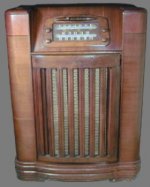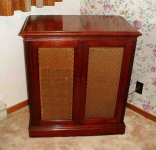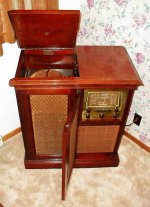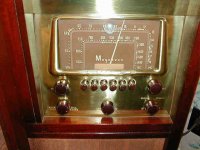This weekend I found a truly fabulous 1946 tube receiver console at a yard sale. It cost a total of 15.00. I was wondering what steps I should follow to begin restoring this antique. The cabinet only needs a little wax and cleanup.
Most if not all of the axial capacitors, I assume, should be documented and replaced. What about the carbon composition resistors. Do they hold up well over time? Will tubes of this period be hard to find?
Any advice or help for the knowledgeable would be much appreciated.
Thanks Tad
Most if not all of the axial capacitors, I assume, should be documented and replaced. What about the carbon composition resistors. Do they hold up well over time? Will tubes of this period be hard to find?
Any advice or help for the knowledgeable would be much appreciated.
Thanks Tad
Got a model number? Probably 46-xxx. I have a number of Philco service buletins on my web page: http://www.audiophool.cjb.net/Philco.html
Caps are bad, resistors my be OK - measure 'em. Tubes may be OK, but are inexpensive and easily found.
Caps are bad, resistors my be OK - measure 'em. Tubes may be OK, but are inexpensive and easily found.
It is Model 46-1209 code 121.
Do you think this old unit would be worthy of restoring. It costs almost 560.00 back in the forties. That was a huge sum of money for a post war radio.
The only reason I bought it , besides being all tubes , was the great condition it is in.
Tad
Do you think this old unit would be worthy of restoring. It costs almost 560.00 back in the forties. That was a huge sum of money for a post war radio.
The only reason I bought it , besides being all tubes , was the great condition it is in.
Tad
Richard,
That is the exact unit I picked up. Is yours in working order?
How does someone with the same last name as ours end up in beautiful Argentina. Wide open unincumbered natural landscape. Anyway, I hope to find the time to restore the inner workings of this old piece of nostalgia. It has shortwave and AM band. I am not sure if it has an FM band. Just think of the musical genre that was played out over these units in the forties and fifties.
Tad Ellis
That is the exact unit I picked up. Is yours in working order?
How does someone with the same last name as ours end up in beautiful Argentina. Wide open unincumbered natural landscape. Anyway, I hope to find the time to restore the inner workings of this old piece of nostalgia. It has shortwave and AM band. I am not sure if it has an FM band. Just think of the musical genre that was played out over these units in the forties and fifties.
Tad Ellis
The s.o.p. is to replace all capacitors- electrolytic and wax/paper, check all resistors and tubes. If you need a schematic, you can download it for free at:
www.nostalgiaair.org
If you any assistance otherwise go to:
www.antiqueradios.com
www.nostalgiaair.org
If you any assistance otherwise go to:
www.antiqueradios.com
I looked at the schematic. This radio will be awesome when you get it working: P-P 6V6GT output section, triodes for the local oscillator and mixer will assure that you have very little converter noise, IIRC 2 stages IF amplification. Well worth restoring and using on a daily basis.
6f6,
Being very new to this hobby and having no experience with tubes makes your comments reassuring. I was not sure if this old unit was worth owning even when it was new. I just figured the price was right and maybe someone might want it.
Now I think I will try and replace all of the old capacitors, clean it up and see what happens. A lot of the wire insulation is broken so that will have to be replaced also.
There are some big capacitors on top with the tubes, I think, which can be restored. Wet type or something????
If I bring it up real slow with a variac I might be able to find other bad items before any real damage occurs.
Where did you locate the schematic for this unit?
Thanks any and all help or comments welcome. Tad
Being very new to this hobby and having no experience with tubes makes your comments reassuring. I was not sure if this old unit was worth owning even when it was new. I just figured the price was right and maybe someone might want it.
Now I think I will try and replace all of the old capacitors, clean it up and see what happens. A lot of the wire insulation is broken so that will have to be replaced also.
There are some big capacitors on top with the tubes, I think, which can be restored. Wet type or something????
If I bring it up real slow with a variac I might be able to find other bad items before any real damage occurs.
Where did you locate the schematic for this unit?
Thanks any and all help or comments welcome. Tad
Tad-
A good source for capacitors and info for your restoration is
Just Radios - small, home-based business in Canada (they ship to the US).
No connection to me, other than the fact that I've had very good service from them in the past. Fresh caps at reasonable prices.
The electrolytic 'can' caps you mentioned can be tricky to find- often they are left in place (disconnected) for appearance and simply replaced with new electrolytics installed inside the chassis. You need to find some room to install them, but most of those old chassis have some available 'real estate' for the smaller modern electrolytics.
Cheers
John
A good source for capacitors and info for your restoration is
Just Radios - small, home-based business in Canada (they ship to the US).
No connection to me, other than the fact that I've had very good service from them in the past. Fresh caps at reasonable prices.
The electrolytic 'can' caps you mentioned can be tricky to find- often they are left in place (disconnected) for appearance and simply replaced with new electrolytics installed inside the chassis. You need to find some room to install them, but most of those old chassis have some available 'real estate' for the smaller modern electrolytics.
Cheers
John
I wrote a lengthy response and this damn thing timed out. Do not apply power at all until you have done the proper work. This means replacing all wax/paper caps and electrolytics. You can put new 'lytics under the chassis or attempt to restuff the old ones. One preliminary test that always perform before putting juice into a radio is to measure the resistance of the leads of the transformer. The high voltage secondary is usually on the order of a few hundred ohms. The filament secondary is usually 3.5-5 ohms. The primary is usually 5 ohms. I do this test to determine check for open windings. I'll write more later so I don't get kicked off.
The schematic is at www.nostalgiaair.org. Click on Resources and you will get the list of all the manufacturers for which there are schematics. Out of curiosity, just how new are you to tubes?
Tad,
Those old console radios can be nice. The real hardwood cabinets are terrific. I picked up a 1948 Magnavox "Berkeley" at a US radio meet that has AM and SW plus automatic turntable. I think I paid $25 for it. The chassis has P-P 6L6's (making 18 watts according to the brochure) and drives two 12" electrodynamic speakers. Every tube in it was totally flat when I got it, yet it played on AM. I completely re-capacitorized and re-tubed it and it sounds great. Got lucky and did not have to replace any electrolytics. I did a long slow soft start with a variac. Needs an alignment though and it would be even better. Lovely cabinet!
Good luck with your electronic restoration.
Those old console radios can be nice. The real hardwood cabinets are terrific. I picked up a 1948 Magnavox "Berkeley" at a US radio meet that has AM and SW plus automatic turntable. I think I paid $25 for it. The chassis has P-P 6L6's (making 18 watts according to the brochure) and drives two 12" electrodynamic speakers. Every tube in it was totally flat when I got it, yet it played on AM. I completely re-capacitorized and re-tubed it and it sounds great. Got lucky and did not have to replace any electrolytics. I did a long slow soft start with a variac. Needs an alignment though and it would be even better. Lovely cabinet!
Good luck with your electronic restoration.
Attachments
Thanks to all of you for the interest and help with my little project.
I have started poking around inside the chassis to determine how much work has been done to this unit before I found it. It seems a few items have been added underneath the chassis in the past. I will try to build it back as close to the schematic as I can and not clutter it up too bad. Most if not all of the wire insulation is cracked and needs to be replaced.
These units must have been assembled my women with very small hands. The caps are packed in rather tight.
Would aligning the tuner be too big of a job to accomplish at home. I believe I have most of the necessary equipment. Just need the knowledge --- a biggee!!
It is almost impossible to believe this thing cost so much in '46. That was postwar and most people were broke. Too bad I can not trace back ownership.
Tad
I have started poking around inside the chassis to determine how much work has been done to this unit before I found it. It seems a few items have been added underneath the chassis in the past. I will try to build it back as close to the schematic as I can and not clutter it up too bad. Most if not all of the wire insulation is cracked and needs to be replaced.
These units must have been assembled my women with very small hands. The caps are packed in rather tight.
Would aligning the tuner be too big of a job to accomplish at home. I believe I have most of the necessary equipment. Just need the knowledge --- a biggee!!
It is almost impossible to believe this thing cost so much in '46. That was postwar and most people were broke. Too bad I can not trace back ownership.
Tad
Would aligning the tuner be too big of a job to accomplish at home. I believe I have most of the necessary equipment. Just need the knowledge --- a biggee!!
The alignment can be done, lots of info on the web how. For example go here http://www.tuberadio.it/docs.htm and look for Resonance and Alignment by Rider. Lots of other info out there.
If you are like me you will realign it just for the fun of it, but from a practical point of view you probably wont have to.
Do all the other suggested work first and then see if stations line up more or less where they should on the dial. Unless someone in the past has fooled around with it or changed critical components it should be OK.
I have a 46-1209 and it's a great looking and performing radio. I got mine back in the early-mid 1990s in my hometown in Virginia. It still had and has it's original finish, back and preset station labels- which is cool because some of those stations are still on the air! I've since moved and that radio is in my living room and used often. Being an early post war radio,Philco hadn't retooled much from war production so, it still looks like a late 30s -early 40s radio.
I found it at the local fleamarket and being new to antique radios, I ran across an old retired fella that was a radio repairman back in the day and he became my elmer. He went through it and got it running in fine shape. Lots of capacitors to replace in that one and some are a little hard to get to. It had a bad band selector switch that he fixed for me. So, after recapping, changing a few resistors and an alignment, that old radio has been playing fine for all these years. I like this radio so much that I found a beater 46-1209 and got the chassis and dial glass from it for backup, just in case. heh
The turntable works, but needs to be cleaned and re-lubed. It also needs a new needle. The 46-1209 came with two different turntables. The D-10 and D-10A . The easier way to tell the two apart is that the D-10A has a shiney metal/chrome strip on the on the tonearm head. The D-10a has a magnetic cartridge and the needles can be found with a little searching, but are not common.
Getting back to the radio, the tuner is sensitive, the pivoting loop antenna works well and that big speaker can pump out the bass.
The only radio that could possibly replace it would be a really nice Zenith, but the Philco would just move to my home office room. Now that I think about it, that sounds like a good idea anyway.
Yeah, antiqueradios.com is a great resource. Register and get on the forums and you'll have just about any question you could think of answered there.
Not much for technical stuff with my reply, but I figured I'd tell my story anyway.
Here's a photo of mine..
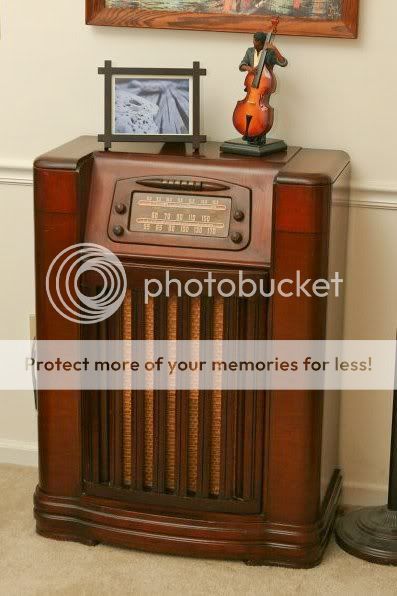
Good luck and keep us posted on your progress,
"rr"
I found it at the local fleamarket and being new to antique radios, I ran across an old retired fella that was a radio repairman back in the day and he became my elmer. He went through it and got it running in fine shape. Lots of capacitors to replace in that one and some are a little hard to get to. It had a bad band selector switch that he fixed for me. So, after recapping, changing a few resistors and an alignment, that old radio has been playing fine for all these years. I like this radio so much that I found a beater 46-1209 and got the chassis and dial glass from it for backup, just in case. heh
The turntable works, but needs to be cleaned and re-lubed. It also needs a new needle. The 46-1209 came with two different turntables. The D-10 and D-10A . The easier way to tell the two apart is that the D-10A has a shiney metal/chrome strip on the on the tonearm head. The D-10a has a magnetic cartridge and the needles can be found with a little searching, but are not common.
Getting back to the radio, the tuner is sensitive, the pivoting loop antenna works well and that big speaker can pump out the bass.
The only radio that could possibly replace it would be a really nice Zenith, but the Philco would just move to my home office room. Now that I think about it, that sounds like a good idea anyway.
Yeah, antiqueradios.com is a great resource. Register and get on the forums and you'll have just about any question you could think of answered there.
Not much for technical stuff with my reply, but I figured I'd tell my story anyway.
Here's a photo of mine..

Good luck and keep us posted on your progress,
"rr"
- Status
- This old topic is closed. If you want to reopen this topic, contact a moderator using the "Report Post" button.
- Home
- Amplifiers
- Tubes / Valves
- 1946 Philco Tube Receiver
